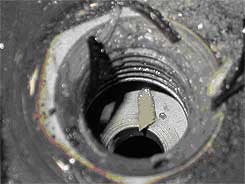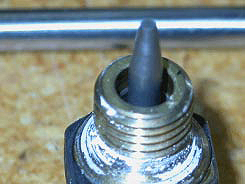Engine Power Loss
Stanton Mackenzie Flying Services Inc.
Cessna 185F C-GAXK
CNJ4 (Mara) Orillia, Ontario, 5 nm E
The Transportation Safety Board of Canada (TSB) investigated this occurrence for the purpose of advancing transportation safety. It is not the function of the Board to assign fault or determine civil or criminal liability. This report is not created for use in the context of legal, disciplinary or other proceedings. See Ownership and use of content. Masculine pronouns and position titles may be used to signify all genders to comply with the Canadian Transportation Accident Investigation and Safety Board Act (S.C. 1989, c. 3).
Summary
The float-equipped Cessna 185F (registration C-GAXK, serial number 18502673) was en route to its home base at Orillia, Ontario, after two passengers and their belongings were picked up at a remote fishing camp about 21 miles to the east of Orillia. After take-off, the aircraft climbed to approximately 1000 feet above ground level (agl) and proceeded towards Orillia. All engine parameters were normal until a few minutes into the flight when the engine (Teledyne Continental IO-520-D) lost power. The pilot moved the mixture control to full rich and selected the auxiliary electric fuel pump on. The engine regained power, and the flight continued towards home base, about five miles away. Shortly thereafter, the pilot switched off the auxiliary fuel pump and the engine immediately lost power. The pilot applied full throttle, switched fuel tanks, and re-selected the auxiliary fuel pump on. However, the engine did not regain power.
An emergency landing was performed in a wetland area at 1308 eastern daylight time. After touchdown, the aircraft travelled a short distance over the soft, wet ground, struck a tree, and came to a stop. One passenger received a minor injury, and all occupants evacuated the aircraft safely. The aircraft was substantially damaged. The pilot was able to maintain radio and cellular telephone communications with another company aircraft flying in the area and with his home base. A short time later, the three occupants were evacuated by a search and rescue helicopter.
Factual information
The in-flight weather conditions were as follows: winds southwest at 5 to 10 knots, visibility six nautical miles (nm) or greater, overcast sky, and temperature 30°C. The automated weather report for Muskoka, Ontario, at 1305 eastern daylight time,Footnote 1 about 16 nm to the north, was as follows: wind 200° at 6 knots, 6 sm visibility, scattered cloud at 2500 feet and 8900 feet, temperature 28°C, dew point 23°C, altimeter 29.85. The automated weather report for Lagoona at 1300, about 12 nm to the south, was as follows: wind 230° at 10 knots, temperature 27°C, dew point 25°C, altimeter 29.84.
Records indicate that the aircraft was maintained in accordance with existing regulations and approved procedures. The pilot was qualified for the flight.
The aircraft was moved from the accident site by helicopter to a hangar at its home base in Orillia. The engine installed on this aircraft was rebuilt at Teledyne Continental in September 2001 and had since accumulated approximately 480 hours. The last maintenance on the aircraft, involving the repair to a leaking propeller blade seal, was performed six weeks before the occurrence. There were 14 hours of flight time remaining until the next 50-hour inspection was due.
The lower side of the engine oil sump was damaged during the occurrence and most of the engine oil had drained. The oil filter was free of contamination, and the spark plugs tested serviceable.
A fuel sample was drained from the fuel gascolator; the colour was consistent with 100LL (low lead) fuel, and it was free of contamination. The internal fuel screen contained a small amount of sediment, but not enough to affect fuel flow and engine power. All of the fuel lines at the rear of the engine compartment were secure with no indication of leakage.
The fuel feed line leading to the fuel distributor was disconnected and the auxiliary fuel pump was selected on so fuel supply and pressure could be verified. When the pump was selected on, fuel flow and fuel pressure increased. The auxiliary pump was selected off and the fuel selector was switched to the other wing tank. The pump was then selected back on to verify fuel flow from the other wing tank. During this and subsequent selections of the auxiliary pump, its operation became intermittent and then finally stopped. The auxiliary fuel pump wiring showed signs of corrosion where it was soldered to the resistor block; contact at the resistor block was minimal.
The engine, electrical wires, and the auxiliary fuel pump switch were removed and transported to the TSB regional wreckage facility for further examination. The fuel components were removed from the engine and taken to an approved overhaul shop for functional tests. With the exception of the engine-driven fuel pump (EDP), all of the components operated in accordance with the manufacturer's specifications. When the fuel flow to the EDP was raised to the manufacturer's specification, the outlet pressure dropped below specification. When the fuel pressure was raised to the manufacturer's specification, fuel flow dropped below specification. The pump was removed from the test stand and disassembled for further examination.
The EDP was examined for damage and wear that may have contributed to the abnormal pump operation. The bypass valve was removed from the vapour separator, and the ball and spring were removed from the EDP. A piece of foreign material, later determined to be thread sealant, was lodged between the ball and its seat (see Photo 1). This was the only abnormality noted. Teledyne Continental Motors (TCM) confirmed that any contaminant lodged between the ball and its seat would unseat the ball and allow fuel to flow through the bypass valve. This would cause a reduction in fuel pressure, which in turn would result in a loss of engine power. Selecting the auxiliary fuel pump on would provide a higher fuel pressure, which would allow the engine to run normally.
Service Information Letter SIL99-2, Revision B, was obtained from TCM. The service letter identified two approved sealants: part number 646940 and Loctite 569® hydraulic sealant. Numerous engine overhaul facilities and distributors were contacted in an attempt to obtain samples of both sealants to compare their composition to the contaminant found in the EDP. When part number 646940 was ordered, a bottle of Loctite 569® was received with part number 646940 displayed on a sticker on the side of the bottle. It was later confirmed by TCM that this was TCM's part number for Loctite 569®.
The sealant found on the threads of the fuel system components and the Loctite 569® were different. The sealant was light beige and brittle, while the Loctite 569® was transparent, red, and sticky. The engine fuel distributor assembly, segments of the EDP with fuel fittings attached, the pipe thread sealant (contaminant), and some samples of Loctite 569® were shipped to the TSB Engineering Laboratory for analysis. It was determined that the two sealants were not chemically identical. Furthermore, the beige sealant was not soluble in fuel and remained in a solid state even after it was immersed in fuel for several days. The amount and distribution of the beige sealant indicated that an excessive amount was applied to the threads on the fuel pump components (see Photo 2).
Assistance was requested from Loctite to determine the origin of the light beige sealant. Loctite suggested that it had the same appearance as its Loctite 565®. A sample was obtained and a spectrograph analysis was performed at the TSB Engineering Laboratory. The results indicated that there was a similarity between the Loctite 565® and the beige sealant. Both samples had the presence of silicon, titanium, oxygen, and carbon. This similarity was not evident when the Loctite 569® was analyzed.
Maintenance entries in the aircraft technical logbooks indicated that a resealing repair was performed on the EDP vapour return line fitting in September 2003 and that the fuel return line on the EDP was replaced in February 2004. A new hose and fitting were installed on the pump in January 2005, and the pressure test of the new line revealed no leakage. The records gave no indication of how or when a piece of sealant could have entered the EDP.
Analysis
Engine power was restored when the pilot applied full rich mixture and selected the auxiliary fuel pump on. The additional fuel pressure from the auxiliary fuel pump was sufficient to maintain engine power. When the auxiliary pump was selected off, the engine immediately lost power again. Re-selecting the auxiliary fuel pump had no effect on the engine operation. Because electrical wiring to the resistor block in the auxiliary fuel pump system was corroded and the contact poor, the pump operation was intermittent, and when the pilot re-selected the pump on, it did not operate.
The piece of foreign material lodged between the ball and the seat within the bypass valve of the EDP resulted in inadequate fuel pressure for normal engine operation unless the auxiliary fuel pump was on.
The following Engineering Laboratory report was completed:
- LP 105/2005 – Fuel Pump Debris Identification
This report is available from the Transportation Safety Board of Canada upon request.
Findings as to Causes and Contributing Factors
- A piece of thread sealant lodged in the bypass valve of the engine-driven fuel pump created a reduction of fuel pressure, preventing normal engine operation.
- A poor electrical connection within the auxiliary fuel pump resulted in intermittent operation of the pump. When the pilot re-selected the pump to provide additional fuel pressure to the engine, it did not operate.
This report concludes the Transportation Safety Board's investigation into this occurrence. Consequently, the Board authorized the release of this report on .

